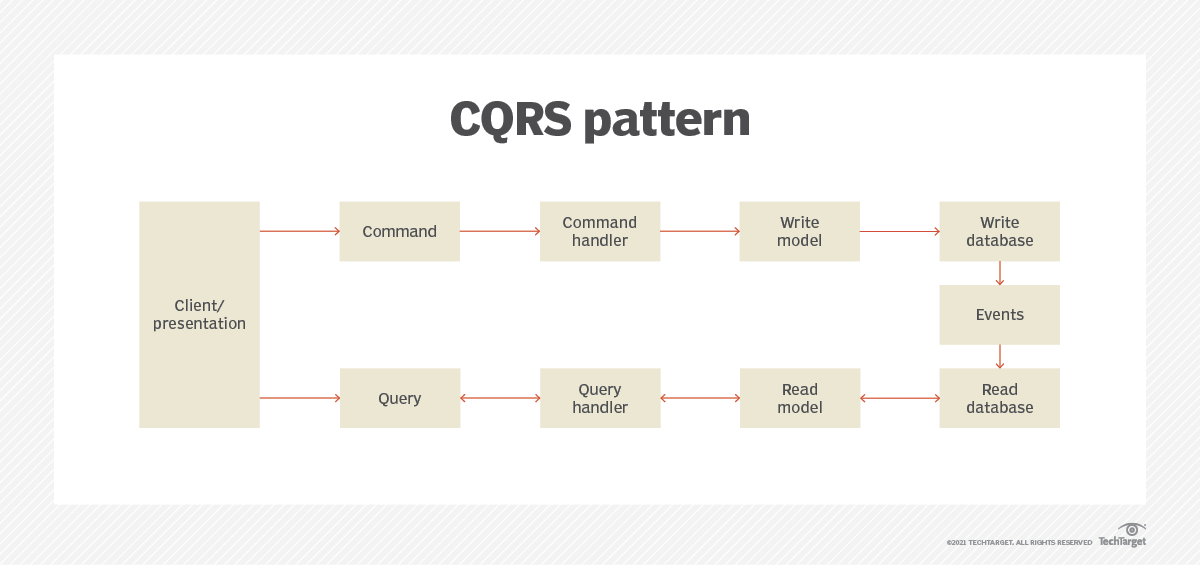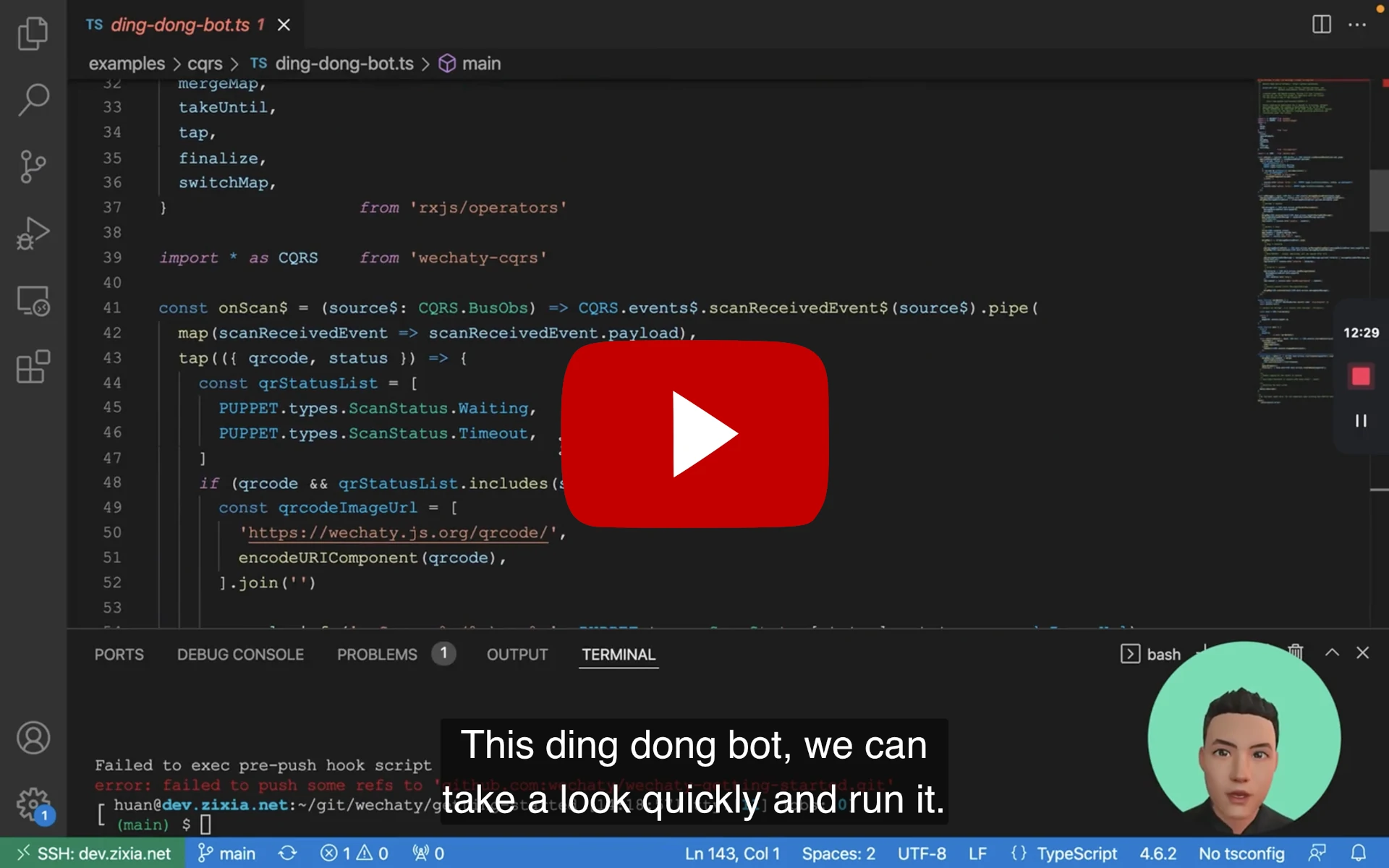An event-driven architecture wrapper for Wechaty that applies the CQS principle by using separate Query and Command messages to retrieve and modify the bot state, respectively.
Image source: Introducing Derivative Event Sourcing
Command query responsibility separation (CQRS) generalises CQS to message-driven and event-driven architectures: it applies the CQS principle by using separate Query and Command messages to retrieve and modify data, respectively.
Image source: CQRS (command query responsibility segregation)
Can we use Wechaty by only sending / receiving the Plain Old JavaScript Object (POJO)?
That's an Event-driven way, which will give us the following benifites:
- Better integration with Domain-driven Design (DDD)
- Decouple the sub-systems with the Wechaty instance completely
- Enable using Wechaty with Microservices
- Make it possible for providing an API endpoint with JSON request/responses
- etc.
So we decided to support the Event-driven Architecture by enabling the Event-driven Programming with Wechaty by publishing the wechaty-cqrs NPM module.
- Convert Wechaty instance to a messaging
bus$with thefrom()function. - Well-defined
commands,queries,responses, andeventspayload creators. - A great
execute$()helper function for sending the events to the bus and get back the response. - Well-defined
events$for the Wechaty events - Well-defined
sayablesfor build all the message contents - Static typing with TypeScript with all events & streams
- Working perfect with the powerful RxJS
npm install wechaty-cqrs wechatyHere's the CQRS version of the Wechaty bot usage:
import * as CQRS from 'wechaty-cqrs'
import * as WECHATY from 'wechaty'
import { filter, map, mergeMap } from 'rxjs/operators'
const wechaty = WECHATY.WechatyBuilder.build()
await wechaty.init()
const bus$ = CQRS.from(wechaty)
bus$.pipe(
filter(CQRS.is(CQRS.events.MessageReceivedEvent)),
// MessageReceivedEvent -> Sayable
map(messageId => CQRS.queries.GetSayablePayloadQuery(
messageReceivedEvent.meta.puppetId,
messageId,Diagrams
)),
mergeMap(CQRS.execute$(bus$)),
// Log `sayable` to console
).subscribe(sayable =>
console.info('Sayable:', sayable),
)
bus$.next(CQRS.commands.StartCommand(wechaty.puppet.id))Learn how to build a Ding Dong BOT with CQRS from our examples/ding-dong-bot.ts
Here's a video introduction for CQRS Wechaty with live demo, presented by Huan:
YouTube: https://youtu.be/kauxyPVa0jo
The getting started ding-dong-bot.ts in the video: https://github.com/wechaty/getting-started/blob/main/examples/cqrs/ding-dong-bot.ts
graph LR
classDef event fill:DarkGoldenRod
classDef command fill:blue
classDef query fill:green
Diagrams
subgraph Command
C(VerbNounCommand):::command
end
subgraph Response
RC(VerbNounCommandResponse)
RQ(GetNounQueryResponse)
end
subgraph Query
Q(GetNounQuery):::query
end
subgraph Event
ER(ReceivedEvent):::event
end
C-->RC
ER-->ER
Q-->RQ
sequenceDiagram
participant Bus
participant Redux
participant Wechaty
Bus->>Redux: ExecuteCommand
Redux->>Wechaty: Call
Wechaty->>Redux: Call Return (void)
Redux->>Bus: ExecuteCommandResponse
sequenceDiagram
participant Bus
participant Redux
participant Wechaty
Bus->>Redux: GetNounQuery
Redux->>Wechaty: Call
Wechaty->>Redux: Call Return (value)
Redux->>Bus: GetNounQueryResponse
sequenceDiagram
participant Bus
participant Redux
participant Wechaty
Wechaty->>Redux: ReceivedEvent
Redux->>Bus: ReceivedEvent
A Data Transfer Object (DTO) is an object that carries data between processes.
CQRS Wechaty has encapsulated all the events to DTOs, exported by:
// You will get DTOs from CQRS.{commands,queries} module
import * as CQRS from 'wechaty-cqrs'
/**
* Examples: building Data Transfer Object for
* - `DingCommand`
* - `GetIsLoggedInQuery
*/
const dingCommand = CQRS.commands.DingCommand(...)
const getIsLoggedInQuery = CQRS.queries.GetIsLoggedInQuery(...)
// Use them as you neededLearn more from the source code
Read CQRS Wechaty API Reference at: https://paka.dev/npm/wechaty-cqrs
The following steps need to be followed:
- Duck
- DTO
- Writing unit tests.
- Layers in DDD microservices
- Effective Aggregate Design
- Domain-Application-Infrastructure Services pattern
- rename all duck events' name from
camelCasetoSNAKE_CASE. (i.e.dingCommand->DING_COMMAMD)
- Classify action builders so that they will be compatible with Class events with NestJS #1
execute$()helper function for sending the events to the bus and get back the response, with automatically type inferring.- lots of typing enhancements.
Learn more from PR #3
- v0.9 (Mar 17,2022): Refactoring(clean) module exports
- v0.7 (Mar 16, 2022): Refactoring
execute$withduck.actionsbuilders. - v0.6 (Mar 13, 2022): Alpha release.
- v0.4 (Mar 13, 2022): CQRS Ding/Dong BOT works as expected.
- v0.2 (Mar 11, 2022): Unit tests all passed, DevOps enabled.
- v0.0.1 (Mar 6, 2022): Init README & Draft design.
Huan LI (李卓桓), Microsoft Regional Director, zixia@zixia.net
- Code & Docs © 2022 Huan (李卓桓) <zixia@zixia.net>
- Code released under the Apache-2.0 License
- Docs released under Creative Commons







